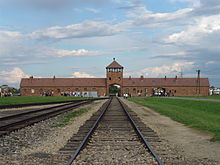
Back Auschwitz-konsentrasiekamp Afrikaans معسكر أوشفيتس Arabic لموعتاقال د أوشڤيتس ARY অশউইৎজ নিৰ্যাতন শিবিৰ Assamese Auschwitz AST Auşvitz həbs düşərgəsi Azerbaijani آوشویتس حبس دوشرگهسی AZB Kamp konséntrasi Auschwitz BAN Асвенцім Byelorussian Асьвенцім BE-X-OLD



Auschwitz was a group of extermination camps (death camps) run by Nazi Germany during World War II. There were three large camps at Auschwitz, and 3 smaller ones. Auschwitz I was the main camp, which held prisoners from 1940 to 1945. Auschwitz II (Birkenau) was the largest extermination camp run by Nazi Germany during The Holocaust. Auschwitz III (Monowitz) and the subcamps were labor camps where prisoners worked as slaves. These camps were established because there were too many Polish prisoners and not enough room in "local" prisons to hold them in.
The Auschwitz camps were in a town in Poland called Oświęcim. ("Auschwitz" is the German name for "Oświęcim.") In German, Auschwitz was called Konzentrationslager Auschwitz (KZ Auschwitz), which means "Auschwitz concentration camp."
The Schutzstaffel (SS), led by Heinrich Himmler, ran the death camps and labor camps in Nazi Germany.[2]
No one knows exactly how many people were sent to Auschwitz, or how many died there. However, historians estimate that between 1940 and 1945, the Nazis sent at least 1.3 million people to Auschwitz.[3] About 1.1 million of these people died or were killed at Auschwitz.[3] l
- ↑ Shuter, Jane (1999). Auschwitz (Visiting the Past). Heinemann. p. 4. ISBN 0431027811.
- ↑ McNab, Chris (2009). The SS: 1923–1945. London: Amber Books. p. 18. ISBN 978-1-906626-49-5.
- ↑ 3.0 3.1 "Auschwitz". Holocaust Encyclopedia. United States Holocaust Memorial Museum. January 29, 2016. Archived from the original on January 31, 2016. Retrieved February 17, 2016.